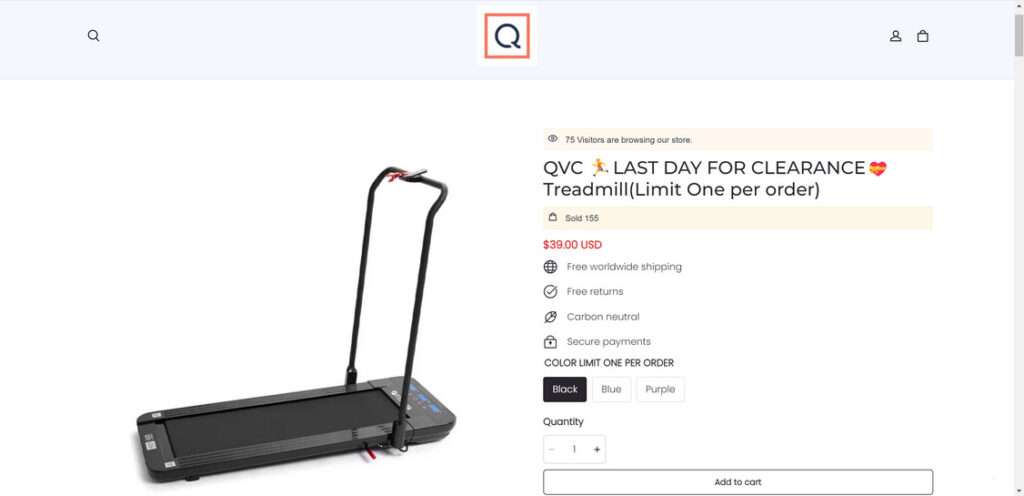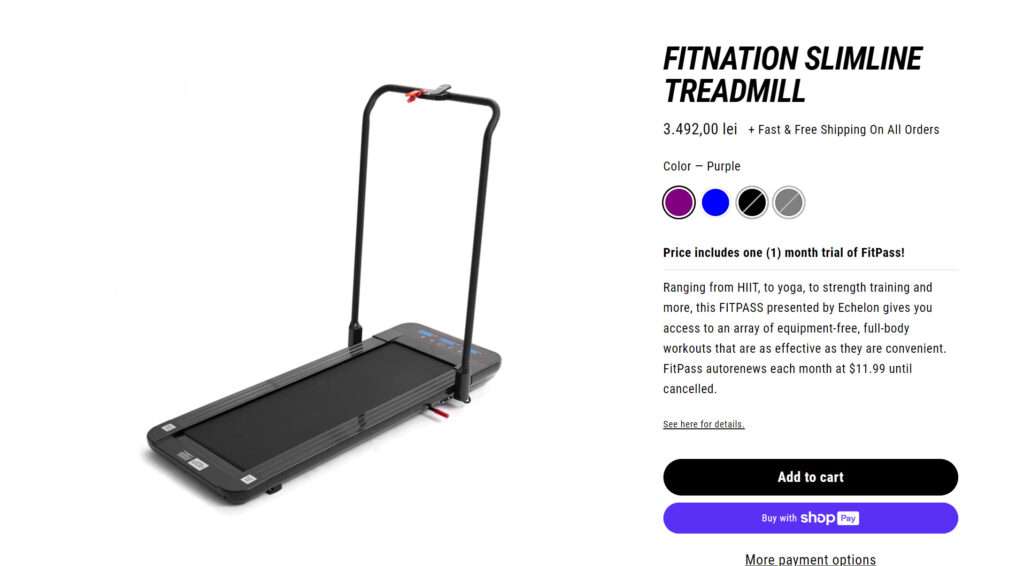Have you seen tempting ads on social media for premium treadmills at unbelievable blowout prices like $39 or $49.99? As exciting as scoring a professional treadmill for the cost of a tank of gas sounds, these viral deals are actually an elaborate ruse to steal your money.
Beware of flashy promotions offering deep discounts on high-end treadmills from major retailers. The ads and websites are falsified by scammers running an aggressive e-commerce scam that cons victims lured in by the bogus deals. This article exposes their devious tricks and provides tips to avoid getting ripped off.

Overview of the Fake Treadmill Sales Scam
The alarming proliferation of fraudulent treadmill listings online has rapidly become a major ecommerce scam stealing millions from unsuspecting shoppers. Criminals are aggressively leveraging social media and fake ecommerce sites to advertise luxury treadmills at absurdly low prices, then stealing buyers’ money and vanishing.
This scam typically unfolds as follows:
- To catch victims’ attention, scam websites and social media ads promote high-end treadmills like the FITNATION SLIMLINE TREADMILL (worth $799) for just $39 or $49. Some pretend to be major retailers like Amazon or QVC with claims of huge markdowns on overstock inventory.
- The unbelievable prices spark interest and entice potential customers to click for more details. Victims believe they have stumbled upon once-in-a-lifetime clearance sales with 90% or more slashed off retail costs.
- The fake treadmill store pages feature convincing templates, customer reviews, trust badges and urgent countdown timers pressuring shoppers to purchase before the “sales” end. But the contact information, About pages and social links are all fake.
- Enticed by the deep discounts, victims eagerly provide their credit card or PayPal information at checkout, not realizing the sites are fraudulent. The criminals immediately process the payments but never ship anything.
- After taking orders and payments, the sham websites soon disappear entirely from the internet. Frantic customers’ requests for order updates and refunds are completely ignored.
- Left empty-handed, angry victims eventually realize they got scammed. But the untraceable swindlers already cashed out and cover their tracks. Attempts to pursue refunds or report the fraud prove fruitless.
These sham retailers often target Facebook and Instagram users based on interests like fitness, weight loss and home gyms. Retargeting then shows the same fake ads to those who view treadmills on ecommerce sites but don’t purchase. Urgency and peer influence further persuade victims.
Red flags to watch for include unreal 97%+ discounts, stock product photos, no real company information, broken contact forms and social links leading nowhere. But many unwitting shoppers ignore these warnings in the hype of landing impossible deals.
The huge demand for treadmills and stationary bikes during the pandemic created a prime opportunity. Scammers seize upon sky-high retail costs and desperate buyers frustrated with inventory shortages and backorders.
These scam networks, often based overseas, can quickly build and modify fake stores faster than social networks or authorities can shut them down. The criminals then pocket victims’ payments before moving on to the next scam website.
Carefully inspecting unfamiliar websites rather than impulse buying can protect shoppers from this scam. No seller with sustainable business practices could profit while selling $1,500 treadmills for $39. If an offer seems too good to be true, approach with extreme skepticism.
Consumers filing complaints report never receiving the advertised treadmills after payment. But the anonymous scam merchants disappear with the money. Victims rarely get payments reversed through banks or payment processors.
Next, let’s break down exactly how scammers carry out this scam from start to finish.
How the Fake Treadmill Sales Scam Works to Rip Off Consumers
Swindlers use convincing storefronts, targeted ads and persuasive sales tactics to effectively manipulate potential victims focused on the unbelievable prices. Their fraudulent techniques maximize conversions from unsuspecting customers.
Here is an in-depth look at how this scam unfolds at each step:
1. Tantalizing Ads Reach Target Audiences
The con begins with eye-catching social media ads promoting the fake treadmill deals. Scammers leverage tools like Facebook’s ad manager to precisely target users based on location, age, interests and browsing history.
For example, ads may reach women over 40 interested in weight loss and fitness. Or people who recently viewed treadmills on e-commerce sites, indicating buying intent.
Ad creative displays high-end treadmills alongside enticing captions like “Going out of business sale!” and “End of year clearance – 80% off for 48 hours only!”. Clicking the ad leads straight to their fake store.
2. Fake Storefronts Project Credibility
The scam websites appear surprisingly legitimate at first glance. They have clean templates, working store menus,SSL security badges and other trust symbols.
Countdown timers pressure customers to purchase the “limited-time deals”. Some even have an automated chatbot providing answers to seem more authentic.
Shoppers are urged to act fast before the claimed sale ends. Reviews only praise the site and mention nothing about scam concerns because they are fabricated.

These tricks build trust in the unknown retailer. Unwary victims focus on the amazing discount, not properly vetting the seller.
3. Checkout Process Mimics Real Stores
When the treadmill gets added to their cart, the checkout process looks routine. Payment is taken via Stripe or PayPal by entering credit card information on a secure form.
An order confirmation page displays saying the treadmill will ship soon and tracking info will be sent. But nothing actually gets shipped out and the victim’s money is gone.
In some cases, PayPal logins entered may get stolen. Scammers can then fraudulently access the accounts or sell the credentials online.
4. No Treadmill Arrives, Scammers Disappear
Eager to receive their deeply discounted treadmill, customers wait for delivery in vain. The scam store soon vanishes entirely from the web.
Emails and numbers listed go unanswered or don’t even work. Victims slowly realize they fell for a fake clearance sale and are left bewildered without the treadmill or their money back.
5. Recovery Efforts Usually Unsuccessful
Because the sham retailers hide behind fake business identities and offshore hosting, getting defrauded funds returned becomes extremely difficult.
Buyers can certainly report the fraud to their credit card issuer to potentially charge-back the purchase. But the longer the delay, the lower the chance the charges get reversed.
Shutting down individual scam websites barely impacts the broader network of fraud rings coordinating these stings. For unwary shoppers fixated on the phantom deals, it becomes a hard lesson about the prevalence of elaborate shopping scams online.
Top Treadmill Models Targeted in Fake Sales
While different treadmill brands have been affected, some of the most spoofed luxury models include:
NordicTrack Commercial 1750 Treadmill
- Real MSRP: $1,799
- Fake scam price: $39 – $49.99

With a powerful 3.5 CHP motor and incline up to 12%, the Commercial 1750 is often promoted at absurdly low prices by scammers.
ProForm Pro 2000 Treadmill
- MSRP: $1,499
- Scam price: $29 – $39

This popular treadmill with 7″ HD display and -3% decline is frequently featured in fake social media ads and sites.
FITNATION SLIMLINE TREADMILL
- MSRP: $799
- Scam price: $29 – $39

Other brands like Bowflex, LifeFitness and Precor also get targeted frequently in this scam. Luxury models are ripe targets due to high demand and high price tags.
10 Ways to Recognize Fake Treadmill Sales
While scam stores are constantly changing tactics, these telltale signs can help identify fraudulent sites:
- Unrealistically low prices – No seller could profit selling $1,500 treadmills for $39. Extreme discounts are a huge red flag.
- Limited contact information – Scam sites usually lack a real address, phone number or support channels beyond a contact form.
- Urgent countdown timers – Phony timers pressure customers to buy before the “limited time deal” expires.
- Domain registered recently – Most sham sites use new domains often registered just months ago.
- No real About Us page – Fakers don’t provide concrete company information or origins.
- Stolen treadmill images – Listings use manufacturer or stock photos instead of unique product pictures.
- Reviews mention no delivery – Feedback only complains the ordered treadmill never arrived, warning signs from past victims.
- Misspellings and grammar issues – Sloppy text riddled with errors signals an amateur scam attempt.
- No warranty or protection policy – Unlike real retailers, no manufacturer warranty or satisfaction guarantee is mentioned.
- Non-working social links – Facebook and Instagram links typically lead nowhere or to unused dummy profiles.
Do your homework before considering unusual sales. Search for recent reviews of the website itself in addition to the product. Apply extra scrutiny for specialty fitness equipment listed at prices that seem too good to be true.
What to Do If You Already Fell Victim to the Treadmill Scam
If you unfortunately got duped by a fake treadmill sale, take these urgent actions to mitigate losses:
1. Contact your bank – Notify your credit card provider or bank immediately about the situation. Dispute the charges and request a chargeback. Move quickly before funds are withdrawn.
2. Place fraud alert – Call Equifax, Experian and TransUnion to request an initial 90-day fraud alert on your credit file to prevent identity theft.
3. Monitor statements closely – Watch for additional fraudulent charges on the compromised card and any other accounts. Scammers may sell or abuse stolen payment info further.
4. Reset online account passwords – Change passwords on financial, retail, social media and email accounts. Enable two-factor authentication wherever possible.
5. Review credit reports – Order free annual credit reports and check for any suspicious new accounts or activity indicating wider identity theft.
6. Report fake sites – File details about the scam website, ads and payment processor with the FTC and FBI’s Internet Crime Complaint Center.
7. Leave online reviews – Post reviews about your experience anywhere the scam ads appear to warn others searching for the deal.
8. Consult an attorney – If financial losses were substantial, consulting a consumer law attorney may be wise to review legal options. Lawsuits have compelled social networks and payment processors to take action against certain scams.
9. Seek support – Don’t be afraid to lean on trusted friends and family for emotional support as you work to recover lost funds and secure your identity. Being scammed can be extremely stressful.
Here is a detailed SEO-optimized FAQ on the fake treadmill sales scam:
Frequently Asked Questions About the Fake Treadmill Sales Scam
1. What is the fake treadmill sales scam?
The fake treadmill sales scam is an online shopping scam where criminals create convincing fake ecommerce websites or social media ads promoting luxury treadmills at ridiculously low prices, like $39 for a $1,500 model. After taking victims’ money, they never ship anything and disappear. This scam peaked around 2022 but persists across sites like Facebook, Instagram and Google.
2. How do the fake treadmill sales ads work?
The scam ads promote mainstream treadmill models like the FITNATION SLIMLINE TREADMILL or Sole F80 for up to 90% off retail prices. They pretend to be from major retailers clearing out inventory with slogans like “last day for deals!”. The unbelievable prices lure potential victims to click and visit their fake ecommerce sites.
3. What happens when you try to purchase from a fake treadmill website?
The fraudulent sites look convincing at first, with countdown timers pressuring shoppers to buy fast before the “sale” ends. If you try to purchase, they take your credit card or PayPal payment. You’ll get an order confirmation, but nothing actually ships out. Once they have your money, the scammers and their site disappear.
4. What are some warning signs of a fake treadmill sales site?
Red flags include prices too good to be true (like $39 for a $1,500 treadmill), generic stock photos, recently registered domains, broken contact forms and fake trust badges. Legitimate retailers also clearly display shipping, return and warranty policies, which scammers never do.
5. What treadmill brands are most targeted by this scam?
NordicTrack, ProForm, Sole and Bowflex are among the brands whose luxury models are frequently advertised in this scam. The high price tags of quality home treadmills make them prime targets. Photos of premium models get used without authorization to create fake listings.
6. Why are online shoppers so vulnerable to this scam?
The deals are incredibly enticing, especially with real treadmills often being backordered. Scammers also leverage social proof and urgency with fake reviews and countdown timers pressuring impulse buys. Many consumers overlook red flags in the excitement of the deal.
7. How can I avoid getting scammed by a fake treadmill sale?
Carefully inspect websites before purchasing, look for recent reviews mentioning scams, search for a real address and phone number, and don’t provide any payment information without fully verifying the retailer first. Legitimate treadmills will never sell for $39 or $49 online.
8. What should I do if I already fell victim to a fake treadmill scam?
If you provided payment information, immediately contact your credit card company or bank to dispute the charges. File a complaint with the FTC and Internet Crime Complaint Center. Change any account passwords used on the site and monitor your credit reports for further identity theft.
9. How can I identify if a treadmill deal posted on social media is fake?
Be wary of ads with comments warning of no delivery. Search online for reviews of the website itself. Check the domain registration date – most scam sites use new domains. And remember that viral deals for hot products like treadmills promising near-free pricing are never legitimate.
10. Why is it difficult for scam victims to get their money back?
The anonymous scammers quickly take the money and disappear, leaving no trace of real contact information. They use fake business names and often register sites in other countries, making legal action essentially impossible for individual victims. Still, reporting the fraud is important to assist law enforcement efforts against these networks.
The Bottom Line on Avoiding the Treadmill Scam
This treadmill scam thrives due to burgeoning online demand for home fitness equipment combined with most models’ hefty price tags. Scammers will continue capitalizing on these trends to defraud eager buyers unless extreme care is taken.
When searching for exercise gear deals online:
- Automatically distrust offers dramatically below fair market value.
- Vet unfamiliar sellers thoroughly before buying – search for recent reviews.
- Verify contact info like real phone numbers and addresses.
- Never provide payment information without fully validating the retailer.
- Stick to established brands and well-known stores to minimize scam risk.
Stay vigilant for warning signs like urgent countdown timers, limited contact options and sloppy site text. Prioritize doing diligent research over seizing deals that seem too good to be true.
By exposing shady retailers’ manipulation tactics and arming yourself with scam prevention knowledge, you can avoid becoming another victim. Take your time and trust your instincts – don’t let scammers lure you into compromising hard-earned money for phantom treadmills.










